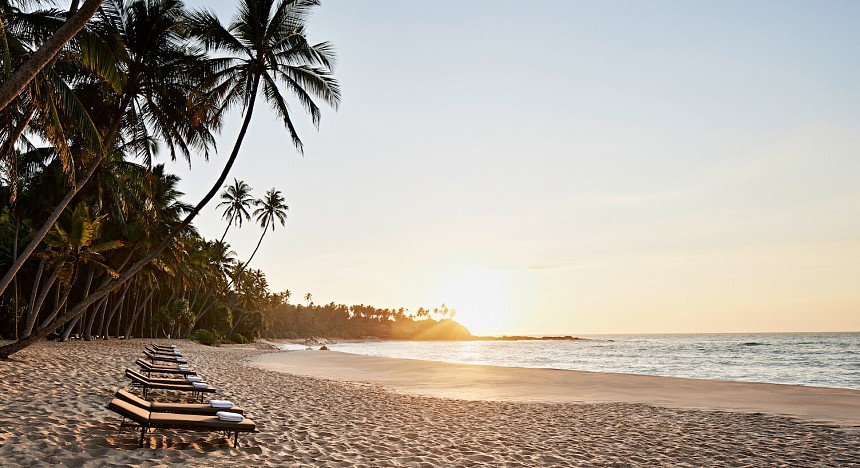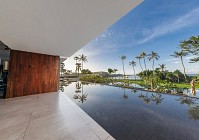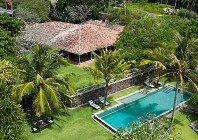Sri Lanka, the beautiful island nation with dazzling golden beaches, verdant hill country and super friendly people, has not had an easy ride. The Civil War devastated the country from 1989 to 2009. Then, just as Sri Lanka was bouncing back, the Easter bombings hit the capital Colombo in 2019. Couple that with Covid a year later and the loss of tourism which sparked the economic crisis last April. However, the country, which celebrated its 75th anniversary of independence in February this year, has emerged unstoppable, with shiny new luxury hotels, game-changing restaurants, and ground-breaking conservation initiatives.

I start my island odyssey in Colombo, once known as the ‘garden city of the East’. A quiet underlying buzz hovers here, darting its way between the towering skyscrapers cheek by jowl with colonial architecture. I wander past stylish eateries, inspired galleries and trendy shops. There’s an ever-growing cosmopolitan vibe – and it’s palpable.

My first stop is Café Kumbuk whose founder Shana Dandeniya was one of the pioneers of Colombo’s thronging café culture. “Our ambition is to create a safe environment for people to dine, work, meet friends and new people. Also, to create a new offering in the market that focuses on highlighting Sri Lankan produce,” Shana tells me. Today, as I savour a naked jackfruit burrito bowl, that combination is obviously working with a newly-updated menu and growing roster of poetry nights, cheese platter workshops and array of independent crafts to buy.

While the cafés are overflowing, so are the high-end restaurants. Housed in the 16th-century Dutch Hospital, Colombo’s world-famous Ministry of Crab tops Asia’s 50 Best Restaurants every year. There are now outposts in Shanghai, Chengdu, Manila, Mumbai, Bangkok and Maldives, with Delhi potentially up next. It’s the small, tightly edited menu which gets everyone talking, entirely centred around one main ingredient: the Sri Lankan mud crab. And my Chilli Crab is, indeed, finger-lickingly good, with fiery local red chillies creating an incredible depth of flavour.

I bed down in Paradise Road Tintagel, a 10-minute drive away along shady boulevards. A handsome 1930s heritage home-turned-eclectic boutique hotel, this bolthole is founded by style maestro Udayshanth Fernando of Colombo design hotspot Paradise Road. Channelling the same monochrome, masculine aesthetic, Baccarat chandeliers sit alongside Chinese wedding cabinets, Vietnamese black lacquer table-tops and Burmese art. The chicness spills over into the east-meets-west cuisine – my beautifully-presented black pork curry was superb, happily followed by the gooey ‘chocolate nemesis’.

While Fernando is a key figure in the interiors’ world right now, it was the late architect Geoffrey Bawa who put Sri Lanka on the design map. This is thanks to his invention of ‘tropical modernism’. Defining the newly-independent Sri Lanka, this architectural style combined traditional and contemporary aesthetics while blending inside and outside spaces. As we drive through Colombo, his masterpieces are evident – most notably, the Sri Lankan Parliament Building, a grand palace, on a man-made island, that looks like it’s floating on water.


There is nowhere better to experience Bawa’s portfolio than his own sprawling home Lunuganga. We head south to beach resort Bentota, where, just inland, the house is enjoying a new dawn. Recently taken over by Teardrop Hotels, who own a series of luxury properties across Sri Lanka, the interiors have barely changed (everything is pretty much as Bawa left it). But there are now nine immaculate rooms, fantastic food and a plethora of fascinating experiences that include a boat safari along mangrove-dense Madu River. Plus, a swimming pool has just opened and Bawa’s own bedroom is now available to stay in for the first time.
-xw0pab.jpg)
Each bedroom is unique. Some are in the main house, others scattered across the estate in pavilions built for Bawa’s architectural students. I stay in the Gatehouse Suite with its Dutch-era antiques, batik prints and bathroom framed by a salvaged antique column. However, this is a place to be outdoors. The garden is magnificent – a jigsaw of Italian Renaissance, English country house and Japanese styles, with butterfly-shaped ponds, emerald rice paddies and verdant lawns peppered with large Ming pots. Bawa died in 2003. Channa Daswatte, the architect’s protégé, took up the mantle and is a major player in the design world today. He was involved in my next stop, Ahu Bay, down the coast in Ahungalla – with his vision of creating a ‘Beach House’. Opened in February 2023, it is one of the first properties from Reverie, the just-launched younger, more intimate brand of Resplendent Ceylon, whose awards-topping boutique hotels dot the country. “Reverie gives us the flexibility to roll out some unusual, innovative concepts,” explains Resplendent Ceylon CEO Malik Fernando.

The result is a trendy beachside hotel. Glossy white with an Ibiza vibe, a blue and white theme decorates the 13 breezy bedrooms, with glistening sea views. I stay in the Bay View Pool Residence, which not only has fun touches with a rope-swing chair, but also a large private pool. The restaurant is the centre point here, with sublime just-caught seafood and on-point cocktails including strong mojitos.
-gtf1rz.jpg)
The delights of the majestic fort-walled town of Galle are an hour away. This UNESCO World Heritage Site hits all the high notes. Majestic Dutch colonial buildings, grand mansions and intricate mosques mingle with cool shops (don’t miss the colourful textiles in Barefoot), buzzy cafes and beautifully-restored hotels which dot the rambling lanes.
One of Galle’s most iconic addresses, Galle Fort Hotel, reopened in February 2023 after a major two-year restoration. Set in a 300-year-old building, there are 11 individually-designed spacious bedrooms. Book the lavish garden suite, with botanical prints, chinoiserie fabrics and a luxurious tub. Vintage wallpaper has been drawn by local artists and furniture hand-crafted by artisans. Best of all, is the colonnaded veranda, which is brilliant for both people-watching and sipping sundowners.

We meander further down the curvaceous coastline, past sandy gems, surfers tackling the barrelling breaks and sunbathers languishing on the shores. As we drive through Weligama, the famous stilt fishermen take to their perch, ready to engage with their catch. We draw into Tangalle in late afternoon. Perfect timing as pristine resort Amanwella is known for being one of the best places on the island to catch sunset, the sky painted purple and orange while casting silhouettes over the swathe of palms.

Reverie’s other new property Kayaam House has just opened in the nearby village of Rekawa. A seaside sanctuary, there are nine high-ceilinged bedrooms with either glorious panoramas of the ocean or jungle. But it is the showstopping food, served in a Bawa-inspired dining room, which strikes me most. Created by chef Namal, fresh from Four Seasons Landaa Giraavaru, dishes include a tender duck breast with pomegranate and cranberry emulsion and an excellent roast lamb with all the trimmings.


Smoke & Bitters has put this area on the map further as the only Sri Lankan pick in Asia’s 50 Best Bars in 2022. Nestled within a coconut grove, this cocktail bar and smokehouse fits right in with palm tree pillars holding up antique ceiling tiles. The menu, with tiki at its heart, is a champion of local spirits and ingredients with syrups and tinctures made in-house. I try The Smokey & Bandit, a heady concoction of Riff Rum Blend, smoked ginger, Lankan bee honey, port and tiki bitters.

It is hard to leave the coast, but one shouldn’t go home without experiencing Sri Lanka’s beautiful wildlife. We continue three hours further south to Yala National Park, which has the highest concentration of leopards per square mile in the world. The park has just been significantly expanded by an extraordinary 27,185.85 hectares and the addition of the Lunugamvehera Park, a major elephant migration route, making it an even bigger feature on Sri Lanka’s revival roadmap.
-jkzean.jpg)
An abundance of animals hides here in the grassy plains, swampy lagoons and light forest. Not just elephants and leopards, you can also spot crocodiles, buffaloes and monkeys amongst many other creatures. It’s a thrilling day-trip if you want to stay beachside, or settle down in Resplendent Ceylon’s chic Wild Coast Tented Lodge with its stylish vintage-themed ‘Cocoon’ rooms. Next, we head to the hills – home to the just-opened Pekoe Trail, the talk of 2023. Funded jointly by the EU and US, it is a magnificent rambling track which zigzags across the undulating tea country. Covering 22 routes across 185 miles, many of the trails were originally used to transport tea to factories by horses. Now it’s a great opportunity for keen walkers to take in dramatic valleys, colonial landmarks and spiritual history.
-i73b6y.jpg)

Teardrop Hotel’s Nine Skies, a beautiful private bungalow, is perfect for trying half- and full-day guided walks on various sections of the Pekoe. And the hotel, too, is embracing the ‘great outdoors’. CEO Henry Fitch says, “We have launched a selection of unique hosted trails, with a fantastic in-house naturalist. These include late night nature trails through tea estates with chance sightings of endemic wildlife along the way, secret viewpoints of the iconic Adam’s Peak with sundowners, and exploring secluded waterfalls and little-known underwater cave networks.”
-[panorama]-o58yu6.jpg)
Further up the hill country, Kandy, with its beautiful centrepiece lake, is a major hub and continually evolving with ambitious development plans. But there’s already plenty to admire, with imposing colonial-era architecture, deep artistic heritage and the Temple of the Sacred Tooth Relic, one of Buddhism’s most sacred shines. Perched on the hillside, about one hour away, is Santani, featured in TIME magazine as one of the 100 greatest places in the world. A deeply beautiful place, it combines exquisite food and an Ayurvedic approach, offering detox, weight-loss and relaxation programmes amongst others. I am whisked into Dr Sachini’s office who cross-questions me about my eating and lifestyle habits before diagnosing my dosha (body type). This goes on to inform my week, from the food to the treatments – some pampering, others more hardcore such as purgation.

Santani is not resting on its laurels. Alongside the particularly excellent yoga, the resort has started introducing visiting masters and is pushing its food offering, with a spectacular tasting menu, the country’s first seven-course Sri Lankan fine dining menu. Founder Vickum Nawagamuwage, Santani’s founder, says: “From a tourism point of view, we are still scratching the surface. Small countries in this region like Singapore, Dubai, Cambodia get over 10 million visitors [a year]. At our peak, we had only 2.2 million. Add in the most amazing offerings a country this size can offer, and Sri Lanka will see exponential growth in the next few years.” It’s no surprise then that Santani is opening a second property on the coast in June.

Wildlife conservation plays an important role for hotels in Sri Lanka too. Back in 2016, Resplendent Ceylon pioneered an impactful leopard conservation centre. Now, it is boutique hotel Ulugalla, a 150-year-old mansion nestled in a lush garden, fostering change with the elephant population, which has declined by as much as 50 per cent. Alongside an Elephant Research Centre open to guests, it has a trained team of individuals dedicated to tracking elephants. In March 2023, the property launched its first-ever community-based village fencing project to mitigate human-elephant conflicts in the area.

It is a six-hour drive back to Colombo – but a beautiful one. As is a holiday in Sri Lanka. Just as Malik confirms: “That Sri Lanka tourism is back to normal, that the peak season is in full swing and travellers from around the world are enjoying memorable holidays must be the best-kept secret in travel. We have everything, the diversity of landscapes and experiences that you would normally only find in a large continent, genuinely warm hospitable people, a decent infrastructure and social framework. The restructure of the economy is well on the way.”
With such voice, vision and dedication of its people to both revive and breathe new life into Sri Lanka, the future is growing ever brighter for this small but mighty Indian Ocean island. And there’s plenty more to come…










